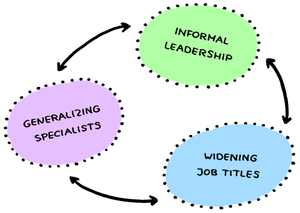In modern businesses managers are expected to be "servant leaders" and "systems thinkers". But nobody…
Cultivate Informal Leadership
Leaders in a team are sometimes called “Leads” or “Chiefs,” like technical leads, project leads, chief programmers, and chief architects. What these people have in common is that they are not the line managers of the others in their teams. Informal leadership is bestowed upon people because of credits earned or commitments made. Or maybe even as a practical joke. It is a responsibility that is completely separate from line management. When several people take up leadership in different areas we might call it distributed informal leadership. Informal leadership follows logically from working with generalizing specialists and using wide job titles.
You can actively cultivate informal leadership in your teams by supporting emergent leadership positions, but it is best to refrain from directly assigning such roles yourself (as a manager). Allow the teams to decide whether they wish to appoint Technical Leads, Project Leads, or some other leading role. (Note that many teams tend to flounder when there’s no strong leadership inside the team. You may need to push them and help them in solving their own leadership problem.)
None of the roles mentioned would involve a management layer. In fact, that is precisely why informal leadership contributes to the adaptability of an organization. By abstaining from a management layer of Chief Somethings and Lead Whatevers you make it much easier for the organization to add, move, and delete such responsibilities. Whenever there’s need for a Chief Graphics Designer, she can be appointed at the spot. And when the need fades away, so does the role. Not the person. If the role was a formal job title, the person would have to be kept busy, or she would have been asked to formally change her job, or else she’d have to get fired for lack of work. All of these are unpleasant measures that suck productivity out of the organization.
 Generalizing specialists, widening job titles, and informal leadership are different but related concepts. Though they tend to reinforce each other, you can introduce one before introducing the others, which might be necessary when gradually changing a bureaucratic organization to a more adaptable one.
Generalizing specialists, widening job titles, and informal leadership are different but related concepts. Though they tend to reinforce each other, you can introduce one before introducing the others, which might be necessary when gradually changing a bureaucratic organization to a more adaptable one.
But please don’t ask me what order would be best in such cases. My experience is mainly with organizations where people were flexible and passionate enough to swallow them all at once.
(photo: The U.S. Army)
This article will be part of the book Management 3.0: Leading Agile Developers, Developing Agile Leaders. You can follow its progress here.
 Twitter –
Twitter –  Subscribe –
Subscribe –  Newsletter –
Newsletter –  LinkedIn –
LinkedIn –  SlideShare
SlideShare
| Latest, greatest and favoritest posts: Widen People’s Job Titles T-Shaped People Managers Are Not Game Designers! |






